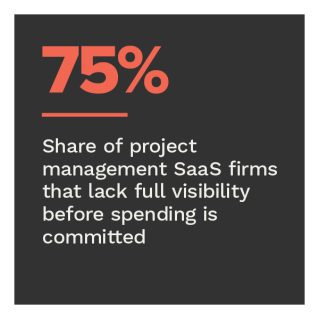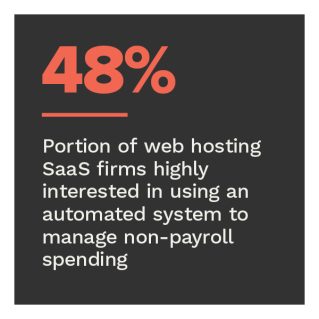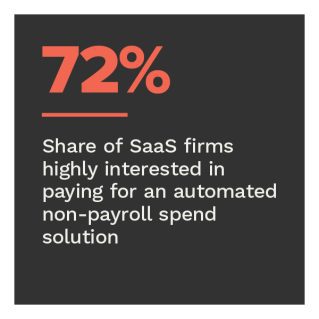Business-to-business (B2B) software-as-a-service (SaaS) solution providers too often lack full visibility and proactive control of their non-payroll spending, including invoices received from suppliers and vendors. A deeper dive into how each type of SaaS solution provider manages their non-payroll spending reveals that these firms rely on time-consuming and inefficient processes that can result in data errors and lost income.
SaaS firms of all types express interest in an alternative system that would streamline how they manage non-payroll spend, enabling accounts payable (AP) teams to work more efficiently. Currently, 62% of customer relationship management (CRM) firms surveyed currently use such a system, yet this share falls to 32% among firms providing web hosting SaaS solutions. Nearly half of these firms are highly interested in using a non-payroll spend management system.
“Improving Financial Performance: How SaaS Firms Manage Non-Payroll Spend,” a PYMNTS and Airbase collaboration, examines the non-payroll spend management challenges experienced by different types of SaaS solution providers — web hosting, eCommerce, content management systems (CMS), project management or customer relationship management (CRM). We surveyed 225 executives with deep knowledge and leadership responsibilities in AP departments at SaaS companies with 100 to 1,500 employees between May 18 and June 6 to explore how an automated system can streamline non-payroll spend management and improve financial performance.

More key findings from the study include:
• Nearly all SaaS firm types use a spend management system to manage expense reimbursements, but other popular uses include managing invoice-based payments to suppliers and employee spending on corporate cards. PYMNTS’ research found that approximately 95% of SaaS firms that provide CRM or project management solutions use a spend management system to manage expense reimbursements. eCommerce firms are the most likely to use these systems to manage suppliers’ invoice payments and employees’ corporate card spending, at 89% and 75%, respectively.
• More than 90% of surveyed firms lack full visibility and control of non-payroll spending. Solving this issue would help all firms save an average of 11% in total spend from wasted spending, with web hosting firms projecting the highest share saved. When managing non-payroll spending, nearly all firms have wasted spending, such as zombie, unauthorized, unwanted, duplicative or unnecessary spend.  Web hosting firms believe they could save 15% if they had full visibility and control of all non-payroll spending, higher than the 11% average for all firms with at least 1% in wasted spending.
Web hosting firms believe they could save 15% if they had full visibility and control of all non-payroll spending, higher than the 11% average for all firms with at least 1% in wasted spending.
• The main issue all SaaS firms face in managing non-payroll spending is a lack of full visibility before spending is committed, with CRM firms the most likely to cite this issue. Manual processing is the second-most common issue for AP teams, and firms providing web hosting SaaS solutions are most likely to have this problem. Eighty percent of SaaS firms that provide CRM solutions cite a lack of full visibility as an issue impeding non-payroll spend management, leading all other types of SaaS firms. While 22% of all firms report problems with manual processing of their non-payroll spending, 40% of web hosting firms cite this issue. Overall, AP teams spend 18% of their time on manual tasks per month, yet web hosting firms spend twice as much time, at 36%.
To learn more about how different types of SaaS solution providers use a non-payroll spend management system, download the report.

